Predation


Predationis abiological interactionwhere one organism, thepredator,kills and eats another organism, itsprey.It is one of a family of commonfeeding behavioursthat includesparasitismandmicropredation(which usually do not kill thehost) andparasitoidism(which always does, eventually). It is distinct fromscavengingon dead prey, though many predators alsoscavenge;it overlaps withherbivory,asseed predatorsand destructivefrugivoresare predators.
Predators may actively search for or pursue prey or wait for it, often concealed. When prey is detected, the predator assesses whether to attack it. This may involveambushorpursuit predation,sometimes after stalking the prey. If the attack is successful, the predator kills the prey, removes any inedible parts like the shell or spines, and eats it.
Predators are adapted and often highly specialized for hunting, with acute senses such asvision,hearing,orsmell.Many predatoryanimals,bothvertebrateandinvertebrate,have sharpclawsorjawsto grip, kill, and cut up their prey. Other adaptations include stealth andaggressive mimicrythat improve hunting efficiency.
Predation has a powerfulselective effecton prey, and the prey developantipredator adaptationssuch aswarning coloration,alarm callsand othersignals,camouflage,mimicryof well-defended species, and defensive spines and chemicals. Sometimes predator and prey find themselves in anevolutionary arms race,a cycle of adaptations and counter-adaptations. Predation has been a major driver ofevolutionsince at least theCambrianperiod.
Definition[edit]

At the most basic level, predators kill and eat other organisms. However, the concept of predation is broad, defined differently in different contexts, and includes a wide variety of feeding methods; moreover, some relationships that result in the prey's death are not necessarily called predation. Aparasitoid,such as anichneumon wasp,lays its eggs in or on its host; the eggs hatch into larvae, which eat the host, and it inevitably dies. Zoologists generally call this a form ofparasitism,though conventionally parasites are thought not to kill their hosts. A predator can be defined to differ from a parasitoid in that it has many prey, captured over its lifetime, where a parasitoid's larva has just one, or at least has its food supply provisioned for it on just one occasion.[1][2]

There are other difficult and borderline cases.Micropredatorsare small animals that, like predators, feed entirely on other organisms; they includefleasandmosquitoesthat consume blood from living animals, andaphidsthat consume sap from living plants. However, since they typically do not kill their hosts, they are now often thought of as parasites.[3][4]Animals thatgrazeonphytoplanktonor mats of microbes are predators, as they consume and kill their food organisms, while herbivores that browse leaves are not, as their food plants usually survive the assault.[5]When animals eat seeds (seed predationorgranivory) or eggs (egg predation), they are consuming entire living organisms, which by definition makes them predators.[6][7][8]
Scavengers,organisms that only eat organisms found already dead, are not predators, but many predators such as thejackaland thehyenascavenge when the opportunity arises.[9][10][5]Among invertebrates,social waspssuch asyellowjacketsare both hunters and scavengers of other insects.[11]
Taxonomic range[edit]
While examples of predators among mammals and birds are well known,[12]predators can be found in a broad range of taxa including arthropods. They are common among insects, including mantids,dragonflies,lacewingsandscorpionflies.In some species such as thealderfly,only the larvae are predatory (the adults do not eat). Spiders are predatory, as well as other terrestrial invertebrates such asscorpions;centipedes;somemites,snailsandslugs;nematodes;andplanarian worms.[13]In marine environments, mostcnidarians(e.g.,jellyfish,hydroids),ctenophora(comb jellies),echinoderms(e.g.,sea stars,sea urchins,sand dollars,andsea cucumbers) andflatwormsare predatory.[14]Amongcrustaceans,lobsters,crabs,shrimpsandbarnaclesare predators,[15]and in turn crustaceans are preyed on by nearly allcephalopods(includingoctopuses,squidandcuttlefish).[16]
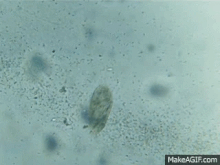
Seed predation is restricted to mammals, birds, and insects but is found in almost all terrestrial ecosystems.[8][6]Egg predation includes both specialist egg predators such as somecolubridsnakesand generalists such as foxes and badgers that opportunistically take eggs when they find them.[17][18][19]
Some plants, like thepitcher plant,theVenus fly trapand thesundew,arecarnivorous and consume insects.[12]Methods of predation by plants varies greatly but often involves a food trap, mechanical stimulation, and electrical impulses to eventually catch and consume its prey.[20]Somecarnivorous fungicatchnematodesusing either active traps in the form of constricting rings, or passive traps with adhesive structures.[21]
Many species ofprotozoa(eukaryotes) andbacteria(prokaryotes) prey on other microorganisms; the feeding mode is evidently ancient, and evolved many times in both groups.[22][12][23]Among freshwater and marinezooplankton,whether single-celled or multi-cellular, predatory grazing onphytoplanktonand smaller zooplankton is common, and found in many species ofnanoflagellates,dinoflagellates,ciliates,rotifers,a diverse range ofmeroplanktonanimal larvae, and two groups of crustaceans, namelycopepodsandcladocerans.[24]
Foraging[edit]
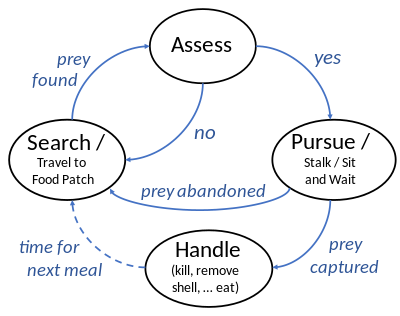
To feed, a predator must search for, pursue and kill its prey. These actions form aforagingcycle.[26][27]The predator must decide where to look for prey based on its geographical distribution; and once it has located prey, it must assess whether to pursue it or to wait for a better choice. If it chooses pursuit, its physical capabilities determine the mode of pursuit (e.g., ambush or chase).[28][29]Having captured the prey, it may also need to expend energyhandlingit (e.g., killing it, removing any shell or spines, and ingesting it).[25][26]
Search[edit]
Predators have a choice of search modes ranging fromsit-and-waittoactiveorwidely foraging.[30][25][31][32]The sit-and-wait method is most suitable if the prey are dense and mobile, and the predator has low energy requirements.[30]Wide foraging expends more energy, and is used when prey is sedentary or sparsely distributed.[28][30]There is a continuum of search modes with intervals between periods of movement ranging from seconds to months. Sharks,sunfish,Insectivorousbirds andshrewsare almost always moving while web-building spiders, aquatic invertebrates, praying mantises andkestrelsrarely move. In between,ploversand othershorebirds,freshwater fish includingcrappies,and the larvae ofcoccinellid beetles (ladybirds),alternate between actively searching and scanning the environment.[30]

Prey distributions are often clumped, and predators respond by looking forpatcheswhere prey is dense and then searching within patches.[25]Where food is found in patches, such as rare shoals of fish in a nearly empty ocean, the search stage requires the predator to travel for a substantial time, and to expend a significant amount of energy, to locate each food patch.[33]For example, theblack-browed albatrossregularly makes foraging flights to a range of around 700 kilometres (430 miles), up to a maximum foraging range of 3,000 kilometres (1,860 miles) for breeding birds gathering food for their young.[a][34]With static prey, some predators can learn suitable patch locations and return to them at intervals to feed.[33]Theoptimal foragingstrategy for search has been modelled using themarginal value theorem.[35]
Search patterns often appear random. One such is theLévy walk,that tends to involve clusters of short steps with occasional long steps. It is agood fit to the behaviourof a wide variety of organisms including bacteria, honeybees, sharks and human hunter-gatherers.[36][37]
Assessment[edit]

Having found prey, a predator must decide whether to pursue it or keep searching. The decision depends on the costs and benefits involved. A bird foraging for insects spends a lot of time searching but capturing and eating them is quick and easy, so the efficient strategy for the bird is to eat every palatable insect it finds. By contrast, a predator such as a lion or falcon finds its prey easily but capturing it requires a lot of effort. In that case, the predator is more selective.[28]
One of the factors to consider is size. Prey that is too small may not be worth the trouble for the amount of energy it provides. Too large, and it may be too difficult to capture. For example, a mantid captures prey with its forelegs and they are optimized for grabbing prey of a certain size. Mantids are reluctant to attack prey that is far from that size. There is a positive correlation between the size of a predator and its prey.[28]
A predator may assess a patch and decide whether to spend time searching for prey in it.[25]This may involve some knowledge of the preferences of the prey; for example,ladybirdscan choose a patch of vegetation suitable for theiraphidprey.[38]
Capture[edit]
To capture prey, predators have a spectrum of pursuit modes that range from overt chase (pursuit predation) to a sudden strike on nearby prey (ambush predation).[25][39][12]Another strategy in between ambush and pursuit isballistic interception,where a predator observes and predicts a prey's motion and then launches its attack accordingly.[40]
Ambush[edit]
Ambush or sit-and-wait predators are carnivorous animals that capture prey by stealth or surprise. In animals, ambush predation is characterized by the predator's scanning the environment from a concealed position until a prey is spotted, and then rapidly executing a fixed surprise attack.[41][40]Vertebrate ambush predators include frogs, fish such as theangel shark,thenorthern pikeand theeastern frogfish.[40][42][43][44]Among the many invertebrate ambush predators aretrapdoor spidersandAustralian Crab spiderson land andmantis shrimpsin the sea.[41][45][46]Ambush predators often construct a burrow in which to hide, improving concealment at the cost of reducing their field of vision. Some ambush predators also use lures to attract prey within striking range.[40]The capturing movement has to be rapid to trap the prey, given that the attack is not modifiable once launched.[40]
Ballistic interception[edit]
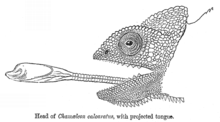
Ballistic interception is the strategy where a predator observes the movement of a prey, predicts its motion, works out an interception path, and then attacks the prey on that path. This differs from ambush predation in that the predator adjusts its attack according to how the prey is moving.[40]Ballistic interception involves a brief period for planning, giving the prey an opportunity to escape. Some frogs wait until snakes have begun their strike before jumping, reducing the time available to the snake to recalibrate its attack, and maximising the angular adjustment that the snake would need to make to intercept the frog in real time.[40]Ballistic predators include insects such as dragonflies, and vertebrates such asarcherfish(attacking with a jet of water),chameleons(attacking with their tongues), and somecolubrid snakes.[40]
Pursuit[edit]
In pursuit predation, predators chase fleeing prey. If the prey flees in a straight line, capture depends only on the predator's being faster than the prey.[40]If the prey manoeuvres by turning as it flees, the predator must react in real time to calculate and follow a new intercept path, such as byparallel navigation,as it closes on the prey.[40]Many pursuit predators use camouflage to approach the prey as close as possible unobserved (stalking) before starting the pursuit.[40]Pursuit predators include terrestrial mammals such as humans, African wild dogs, spotted hyenas and wolves; marine predators such as dolphins, orcas and many predatory fishes, such as tuna;[47][48]predatory birds (raptors) such as falcons; and insects such asdragonflies.[49]
An extreme form of pursuit isendurance or persistence hunting,in which the predator tires out the prey by following it over a long distance, sometimes for hours at a time. The method is used by humanhunter-gatherersand bycanidssuch asAfrican wild dogsand domestic hounds. The African wild dog is an extreme persistence predator, tiring out individual prey by following them for many miles at relatively low speed.[50]
A specialised form of pursuit predation is thelunge feedingofbaleen whales.These very large marine predators feed onplankton,especiallykrill,diving and actively swimming into concentrations of plankton, and then taking a huge gulp of water andfilteringit through their featherybaleenplates.[51][52]
Pursuit predators may besocial,like the lion and wolf that hunt in groups, or solitary.[2]
Handling[edit]
Once the predator has captured the prey, it has to handle it: very carefully if the prey is dangerous to eat, such as if it possesses sharp or poisonous spines, as in many prey fish. Somecatfishsuch as theIctaluridaehavespines on the back (dorsal) and belly (pectoral)which lock in the erect position; as the catfish thrashes about when captured, these could pierce the predator's mouth, possibly fatally. Some fish-eating birds like theospreyavoid the danger of spines by tearing up their prey before eating it.[53]
Solitary versus social predation[edit]
In social predation, a group of predators cooperates to kill prey. This makes it possible to kill creatures larger than those they could overpower singly; for example,hyenas,andwolvescollaborate to catch and kill herbivores as large as buffalo, and lions even hunt elephants.[54][55][56]It can also make prey more readily available through strategies like flushing of prey and herding it into a smaller area. For example, when mixed flocks of birds forage, the birds in front flush out insects that are caught by the birds behind.Spinner dolphinsform a circle around a school of fish and move inwards, concentrating the fish by a factor of 200.[57]By hunting sociallychimpanzeescan catchcolobus monkeysthat would readily escape an individual hunter, while cooperatingHarris hawkscan trap rabbits.[54][58]

Predators of different species sometimes cooperate to catch prey. Incoral reefs,when fish such as thegrouperandcoral troutspot prey that is inaccessible to them, they signal togiant moray eels,Napoleon wrassesoroctopuses.These predators are able to access small crevices and flush out the prey.[59][60]Killer whaleshave been known to help whalers huntbaleen whales.[61]
Social hunting allows predators to tackle a wider range of prey, but at the risk of competition for the captured food. Solitary predators have more chance of eating what they catch, at the price of increased expenditure of energy to catch it, and increased risk that the prey will escape.[62][63]Ambush predators are often solitary to reduce the risk of becoming prey themselves.[64]Of 245 terrestrial members of theCarnivora(the group that includes the cats, dogs, and bears), 177 are solitary; and 35 of the 37wild catsare solitary,[65]including the cougar and cheetah.[62][2]However, the solitary cougar does allow other cougars to share in a kill,[66]and thecoyotecan be either solitary or social.[67]Other solitary predators include the northern pike,[68]wolf spidersand all the thousands of species ofsolitary waspsamong arthropods,[69][70]and manymicroorganismsandzooplankton.[22][71]
Specialization[edit]
Physical adaptations[edit]
Under the pressure ofnatural selection,predators have evolved a variety of physicaladaptationsfor detecting, catching, killing, and digesting prey. These include speed, agility, stealth, sharp senses, claws, teeth, filters, and suitable digestive systems.[72]
Fordetecting prey,predators have well-developedvision,smell,orhearing.[12]Predators as diverse asowlsandjumping spidershave forward-facing eyes, providing accuratebinocular visionover a relatively narrow field of view, whereas prey animals often have less acute all-round vision. Animals such as foxes can smell their prey even when it is concealed under 2 feet (60 cm) of snow or earth. Many predators have acute hearing, and some such asecholocatingbatshunt exclusively by active or passive use of sound.[73]
Predators includingbig cats,birds of prey,and ants share powerful jaws, sharp teeth, or claws which they use to seize and kill their prey. Some predators such assnakesand fish-eating birds likeheronsandcormorantsswallow their prey whole; some snakes can unhinge their jaws to allow them to swallow large prey, while fish-eating birds have long spear-like beaks that they use to stab and grip fast-moving and slippery prey.[73]Fish and other predators have developed the ability to crush or open the armoured shells of molluscs.[74]
Many predators are powerfully built and can catch and kill animals larger than themselves; this applies as much to small predators such asantsandshrewsas to big and visibly muscular carnivores like thecougarandlion.[73][2][75]
-
Skull ofbrown bearhas large pointedcaninesfor killing prey, and self-sharpeningcarnassialteeth at rear for cutting flesh with a scissor-like action
-
Crab spider,anambush predatorwith forward-facing eyes, catching another predator, afield digger wasp
-
Red-tailed hawkuses sharp hooked claws and beak to kill and tear up its prey
-
Specialist: agreat blue heronwith a speared fish
-
Indian Pythonunhinges its jaw to swallow large prey like thischital
Diet and behaviour[edit]
Predators are often highly specialized in their diet and hunting behaviour; for example, theEurasian lynxonly hunts smallungulates.[76]Others such asleopardsare more opportunistic generalists, preying on at least 100 species.[77][78]The specialists may be highly adapted to capturing their preferred prey, whereas generalists may be better able to switch to other prey when a preferred target is scarce. When prey have a clumped (uneven) distribution, the optimal strategy for the predator is predicted to be more specialized as the prey are more conspicuous and can be found more quickly;[79]this appears to be correct for predators of immobile prey, but is doubtful with mobile prey.[80]
In size-selective predation, predators select prey of a certain size.[81]Large prey may prove troublesome for a predator, while small prey might prove hard to find and in any case provide less of a reward. This has led to a correlation between the size of predators and their prey. Size may also act as arefugefor large prey. For example, adult elephants are relatively safe from predation by lions, but juveniles are vulnerable.[82]
Camouflage and mimicry[edit]
Members of thecat familysuch as thesnow leopard(treeless highlands),tiger(grassy plains, reed swamps),ocelot(forest),fishing cat(waterside thickets), andlion(open plains) are camouflaged with coloration anddisruptive patternssuiting their habitats.[83]
Inaggressive mimicry,certain predators, including insects and fishes, make use of coloration and behaviour to attract prey. FemalePhoturisfireflies,for example, copy the light signals of other species, thereby attracting male fireflies, which they capture and eat.[84]Flower mantisesare ambush predators; camouflaged as flowers, such asorchids,they attract prey and seize it when it is close enough.[85]Frogfishesare extremely well camouflaged, and actively lure their prey to approach using anesca,a bait on the end of a rod-like appendage on the head, which they wave gently to mimic a small animal, gulping the prey in an extremely rapid movement when it is within range.[86]
Venom[edit]
Many smaller predators such as thebox jellyfishusevenomto subdue their prey,[87]and venom can also aid in digestion (as is the case forrattlesnakesand somespiders).[88][89]Themarbled sea snakethat has adapted to egg predation has atrophied venom glands, and the gene for its three finger toxin contains amutation(the deletion of twonucleotides) that inactives it. These changes are explained by the fact that its prey does not need to be subdued.[90]
Electric fields[edit]
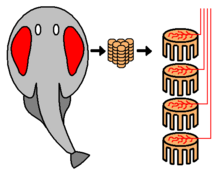
Several groups of predatory fish have the ability to detect, track, and sometimes, as in theelectric ray,to incapacitate their prey bysensing and generating electric fields.[91][92][93]The electric organ is derived from modified nerve or muscle tissue.[94]
Physiology[edit]
Physiological adaptations to predation include the ability of predatory bacteria to digest the complexpeptidoglycanpolymer from thecell wallsof the bacteria that they prey upon.[23]Carnivorous vertebrates of all five major classes (fishes, amphibians, reptiles, birds, and mammals) have lower relative rates of sugar toamino acidtransport than either herbivores or omnivores, presumably because they acquire plenty of amino acids from the animalproteinsin their diet.[95]
Antipredator adaptations[edit]
To counter predation, prey have evolved defences for use at each stage of an attack.[96][12]They can try to avoid detection,[97]such as by usingcamouflageandmimicry.[98]They can detect predators[99]and warn others of their presence.[100][101] If detected, they can try to avoid being the target of an attack, for example, bysignalling that they are toxic or unpalatable,[102][103][104]by signalling that a chase would be unprofitable,[105][106]or by forming groups.[107][108]If they become a target, they can try to fend off the attack with defences such as armour,quills,unpalatability, or mobbing;[109][110][111]and they can often escape an attack in progress bystartlingthe predator,[112][113][114]playing dead,shedding body parts such as tails, or simply fleeing.[115][116]
Coevolution[edit]

Predators and prey are natural enemies, and many of their adaptations seem designed to counter each other. For example, bats have sophisticatedecholocationsystems to detect insects and other prey, and insects have developed a variety of defences including the ability to hear the echolocation calls.[117][118]Many pursuit predators that run on land, such as wolves, have evolved long limbs in response to the increased speed of their prey.[119]Their adaptations have been characterized as anevolutionary arms race,an example of thecoevolutionof two species.[120]In agene centered view of evolution,the genes of predator and prey can be thought of ascompetingfor the prey's body.[120]However, the "life-dinner" principle of Dawkins and Krebs predicts that this arms race is asymmetric: if a predator fails to catch its prey, it loses its dinner, while if it succeeds, the prey loses its life.[120]

The metaphor of an arms race implies ever-escalating advances in attack and defence. However, these adaptations come with a cost; for instance, longer legs have an increased risk of breaking,[121]while the specialized tongue of the chameleon, with its ability to act like a projectile, is useless for lapping water, so the chameleon must drink dew off vegetation.[122]
The "life-dinner" principle has been criticized on multiple grounds. The extent of the asymmetry in natural selection depends in part on the heritability of the adaptive traits.[122]Also, if a predator loses enough dinners, it too will lose its life.[121][122]On the other hand, the fitness cost of a given lost dinner is unpredictable, as the predator may quickly find better prey. In addition, most predators are generalists, which reduces the impact of a given prey adaption on a predator. Since specialization is caused by predator-prey coevolution, the rarity of specialists may imply that predator-prey arms races are rare.[122]
It is difficult to determine whether given adaptations are truly the result of coevolution, where a prey adaptation gives rise to a predator adaptation that is countered by further adaptation in the prey. An alternative explanation isescalation,where predators are adapting to competitors, their own predators or dangerous prey.[123]Apparent adaptations to predation may also have arisen for other reasons and then been co-opted for attack or defence. In some of the insects preyed on by bats, hearing evolved before bats appeared and was used to hear signals used for territorial defence and mating.[124]Their hearing evolved in response to bat predation, but the only clear example of reciprocal adaptation in bats is stealth echolocation.[125]
A more symmetric arms race may occur when the prey are dangerous, having spines, quills, toxins or venom that can harm the predator. The predator can respond with avoidance, which in turn drives the evolution of mimicry. Avoidance is not necessarily an evolutionary response as it is generally learned from bad experiences with prey. However, when the prey is capable of killing the predator (as can acoral snakewith its venom), there is no opportunity for learning and avoidance must be inherited. Predators can also respond to dangerous prey with counter-adaptations. In western North America, thecommon garter snakehas developed a resistance to the toxin in the skin of therough-skinned newt.[122]
Role in ecosystems[edit]
Predators affect their ecosystems not only directly by eating their own prey, but by indirect means such as reducing predation by other species, or altering the foraging behaviour of a herbivore, as with the biodiversity effect of wolves on riverside vegetation or sea otters on kelp forests. This may explain population dynamics effects such as the cycles observed in lynx and snowshoe hares.[126][127][128]
Trophic level[edit]
One way of classifying predators is bytrophic level.Carnivoresthat feed onherbivoresare secondary consumers; their predators are tertiary consumers, and so forth.[129]At the top of thisfood chainareapex predatorssuch aslions.[130]Many predators however eat from multiple levels of the food chain; a carnivore may eat both secondary and tertiary consumers.[131]This means that many predators must contend withintraguild predation,where other predators kill and eat them. For example,coyotescompete with and sometimes killgray foxesandbobcats.[132]
Trophic transfer[edit]
Trophic transfer within an ecosystem refers to the transport of energy andnutrientsas a result of predation. Energy passes from onetrophic levelto the next as predators consumeorganic matterfrom anotherorganism's body. Within each transfer, while there are uses of energy, there are also losses of energy.
Marine trophic levels vary depending on locality and the size of theprimary producers.There are generally up to six trophic levels in the open ocean, four over continental shelves, and around three in upwelling zones.[133]For example, a marine habitat with five trophic levels could be represented as follows:Herbivores(feed primarily onphytoplankton);Carnivores(feed primarily on otherzooplankton/animals);Detritivores(feed primarily on dead organic matter/detritus;Omnivores(feed on a mixed diet of phyto- and zooplankton and detritus); andMixotrophswhich combineautotrophy(using light energy to grow without intake of any additional organic compounds or nutrients) withheterotrophy(feeding on other plants and animals for energy and nutrients—herbivores, omnivores and carnivores, and detritivores).
Trophic transfer efficiency measures how effectively energy is transferred or passed up through higher trophic levels of the marinefood web.As energy moves up the trophic levels, it decreases due to heat, waste, and the naturalmetabolic processesthat occur as predators consume their prey. The result is that only about 10% of the energy at any trophic level is transferred to the next level. This is often referred to as "the 10% rule" which limits the number of trophic levels that an individual ecosystem is capable of supporting.[134]
Biodiversity maintained by apex predation[edit]
Predators may increase thebiodiversityof communities by preventing a single species from becoming dominant. Such predators are known askeystone speciesand may have a profound influence on the balance of organisms in a particularecosystem.[135]Introduction or removal of this predator, or changes in its population density, can have drastic cascading effects on the equilibrium of many other populations in the ecosystem. For example, grazers of a grassland may prevent a single dominant species from taking over.[136]

The elimination of wolves fromYellowstone National Parkhad profound impacts on thetrophic pyramid.In that area, wolves are both keystone species and apex predators. Without predation, herbivores began to over-graze many woody browse species, affecting the area's plant populations. In addition, wolves often kept animals from grazing near streams, protecting thebeavers' food sources. The removal of wolves had a direct effect on the beaver population, as their habitat became territory for grazing. Increased browsing onwillowsandconifersalong Blacktail Creek due to a lack of predation caused channel incision because the reduced beaver population was no longer able to slow the water down and keep the soil in place. The predators were thus demonstrated to be of vital importance in the ecosystem.[137]
Population dynamics[edit]
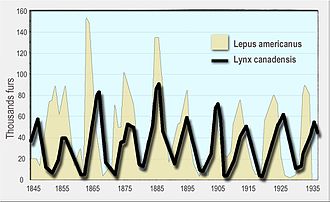
In the absence of predators, the population of a species can grow exponentially until it approaches thecarrying capacityof the environment.[138]Predators limit the growth of prey both by consuming them and by changing their behavior.[139]Increases or decreases in the prey population can also lead to increases or decreases in the number of predators, for example, through an increase in the number of young they bear.
Cyclical fluctuations have been seen in populations of predator and prey, often with offsets between the predator and prey cycles. A well-known example is that of thesnowshoe hareandlynx.Over a broad span ofboreal forestsin Alaska and Canada, the hare populations fluctuate in near synchrony with a 10-year period, and the lynx populations fluctuate in response. This was first seen in historical records of animals caught byfur huntersfor theHudson's Bay Companyover more than a century.[140][128][141][142]

A simple model of a system with one species each of predator and prey, theLotka–Volterra equations,predicts population cycles.[143]However, attempts to reproduce the predictions of this model in the laboratory have often failed; for example, when the protozoanDidinium nasutumis added to a culture containing its prey,Paramecium caudatum,the latter is often driven to extinction.[144]
The Lotka–Volterra equations rely on several simplifying assumptions, and they arestructurally unstable,meaning that any change in the equations can stabilize or destabilize the dynamics.[145][146]For example, one assumption is that predators have a linearfunctional responseto prey: the rate of kills increases in proportion to the rate of encounters. If this rate is limited by time spent handling each catch, then prey populations can reach densities above which predators cannot control them.[144]Another assumption is that all prey individuals are identical. In reality, predators tend to select young, weak, and ill individuals, leaving prey populations able to regrow.[147]
Many factors can stabilize predator and prey populations.[148]One example is the presence of multiple predators, particularly generalists that are attracted to a given prey species if it is abundant and look elsewhere if it is not.[149]As a result, population cycles tend to be found in northern temperate andsubarcticecosystems because the food webs are simpler.[150]The snowshoe hare-lynx system is subarctic, but even this involves other predators, including coyotes,goshawksandgreat horned owls,and the cycle is reinforced by variations in the food available to the hares.[151]
A range of mathematical models have been developed by rela xing the assumptions made in the Lotka–Volterra model; these variously allow animals to havegeographic distributions,or tomigrate;to have differences between individuals, such assexesand anage structure,so that only some individuals reproduce; to live in a varying environment, such as with changingseasons;[152][153]and analysing the interactions of more than just two species at once. Such models predict widely differing and oftenchaoticpredator-prey population dynamics.[152][154]The presence ofrefuge areas,where prey are safe from predators, may enable prey to maintain larger populations but may also destabilize the dynamics.[155][156][157][158]
Evolutionary history[edit]
Predation dates from before the rise of commonly recognized carnivores by hundreds of millions (perhaps billions) of years. Predation has evolved repeatedly in different groups of organisms.[5][159]The rise ofeukaryoticcells at around 2.7 Gya, the rise of multicellular organisms at about 2 Gya, and the rise of mobile predators (around 600 Mya - 2 Gya, probably around 1 Gya) have all been attributed to early predatory behavior, and many very early remains show evidence of boreholes or other markings attributed to small predator species.[5]It likely triggered major evolutionary transitions including the arrival ofcells,eukaryotes,sexual reproduction,multicellularity,increased size, mobility (includinginsect flight[160]) and armoured shells and exoskeletons.[5]
The earliest predators were microbial organisms, which engulfed or grazed on others. Because the fossil record is poor, these first predators could date back anywhere between 1 and over 2.7 Gya (billion years ago).[5]Predation visibly became important shortly before theCambrianperiod—around550million years ago—as evidenced by the almost simultaneous development ofcalcificationin animals and algae,[161]and predation-avoidingburrowing.However, predators had been grazing on micro-organisms since at least1,000million years ago,[5][162][163]with evidence of selective (rather than random) predation from a similar time.[164]
Auroralumina attenboroughiiis an Ediacaran crown-groupcnidarian(557–562 mya, some 20 million years before the Cambrian explosion) fromCharnwood Forest,England. It is thought to be one of the earliest predatory animals, catching small prey with itsnematocystsas modern cnidarians do.[165]
Thefossil recorddemonstrates a long history of interactions between predators and their prey from the Cambrian period onwards, showing for example that some predators drilled through the shells ofbivalveandgastropodmolluscs, while others ate these organisms by breaking their shells.[166] Among the Cambrian predators were invertebrates like theanomalocarididswith appendages suitable for grabbing prey, large compound eyes and jaws made of a hard material like that in theexoskeletonof an insect.[167] Some of the firstfish to have jawswere the armoured and mainly predatoryplacodermsof theSiluriantoDevonianperiods, one of which, the 6 m (20 ft)Dunkleosteus,is considered the world's firstvertebrate"superpredator", preying upon other predators.[168][169] Insectsdeveloped the ability to fly in the EarlyCarboniferousor Late Devonian, enabling them among other things to escape from predators.[160] Among the largest predators that have ever lived were thetheropod dinosaurssuch asTyrannosaurusfrom theCretaceousperiod. They preyed upon herbivorous dinosaurs such ashadrosaurs,ceratopsiansandankylosaurs.[170]
-
Auroralumina attenboroughii,anEdiacaranpredator (c. 560 mya). It was a stem-groupcnidarian,catching prey with itsnematocysts.[165]
-
TheCambrian substrate revolutionsaw life on thesea floorchange from minimal burrowing (left) to a diverse burrowing fauna (right), probably to avoid newCambrianpredators.
-
Meganeura monyi,a predatoryCarboniferousinsectrelated todragonflies,could fly to escape terrestrial predators. Its large size, with a wingspan of 65 cm (30 in), may reflect the lack of vertebrate aerial predators at that time.
In human society[edit]

Practical uses[edit]
Humans, asomnivores,are to some extent predatory,[171]using weapons and tools tofish,[172]huntandtrapanimals.[173]They also use other predatory species such asdogs,cormorants,[174]andfalconsto catch prey for food or for sport.[175] Two mid-sized predators, dogs and cats, are the animals most often kept aspetsin western societies.[176][177] Human hunters, including theSanof southern Africa, usepersistence hunting,a form of pursuit predation where the pursuer may be slower than prey such as akuduantelope over short distances, but follows it in the midday heat until it is exhausted, a pursuit that can take up to five hours.[178][179]
Inbiological pest control,predators (and parasitoids) from a pest's natural range are introduced to control populations, at the risk of causing unforeseen problems. Natural predators, provided they do no harm to non-pest species, are an environmentally friendly and sustainable way of reducing damage to crops and an alternative to the use of chemical agents such aspesticides.[180]
Symbolic uses[edit]
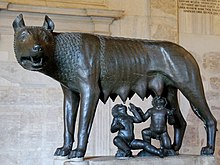
In film, the idea of the predator as a dangerous ifhumanoidenemy is used in the 1987science fictionhorroraction filmPredatorandits three sequels.[181][182]A terrifying predator, a giganticman-eatinggreat white shark,is central, too, toSteven Spielberg's 1974 thrillerJaws.[183]
Among poetry on the theme of predation, a predator's consciousness might be explored, such as inTed Hughes'sPike.[184]The phrase "Nature, red in tooth and claw" fromAlfred, Lord Tennyson's 1849 poem "In Memoriam A.H.H."has been interpreted as referring to the struggle between predators and prey.[185]
In mythology and folk fable, predators such as the fox and wolf have mixed reputations.[186]The fox was a symbol of fertility in ancient Greece, but a weather demon in northern Europe, and a creature of the devil in early Christianity; the fox is presented as sly, greedy, and cunning in fables fromAesoponwards.[186]The big bad wolf is known to children in tales such asLittle Red Riding Hood,but is a demonic figure in the IcelandicEddasagas, where the wolfFenrirappears in the apocalypticending of the world.[186]In the Middle Ages, belief spread inwerewolves,men transformed into wolves.[186]In ancient Rome, and in ancient Egypt, the wolf was worshipped, the she-wolf appearing in the founding myth of Rome, sucklingRomulus and Remus.[186]More recently, inRudyard Kipling's 1894The Jungle Book,Mowgli is raised by the wolf pack.[186]Attitudes to large predators in North America, such as wolf,grizzly bearand cougar, have shifted from hostility or ambivalence, accompanied by active persecution, towards positive and protective in the second half of the 20th century.[187]
See also[edit]
Notes[edit]
- ^A range of 3000 kilometres means a flight distance of at least 6000 kilometres out and back.
References[edit]
- ^Gurr, Geoff M.; Wratten, Stephen D.; Snyder, William E. (2012).Biodiversity and Insect Pests: Key Issues for Sustainable Management.John Wiley & Sons. p. 105.ISBN978-1-118-23185-2.
- ^abcdLafferty, K. D.; Kuris, A. M. (2002). "Trophic strategies, animal diversity and body size".Trends Ecol. Evol.17(11): 507–513.doi:10.1016/s0169-5347(02)02615-0.
- ^Poulin, Robert;Randhawa, Haseeb S. (February 2015)."Evolution of parasitism along convergent lines: from ecology to genomics".Parasitology.142(Suppl 1): S6–S15.doi:10.1017/S0031182013001674.PMC4413784.PMID24229807.
- ^Poulin, Robert(2011). Rollinson, D.; Hay, S. I. (eds.)."The Many Roads to Parasitism: A Tale of Convergence".Advances in Parasitology.74.Academic Press: 27–28.doi:10.1016/B978-0-12-385897-9.00001-X.ISBN978-0-12-385897-9.PMID21295676.
- ^abcdefgBengtson, S. (2002). "Origins and early evolution of predation". In Kowalewski, M.; Kelley, P. H. (eds.).The fossil record of predation. The Paleontological Society Papers 8(PDF).The Paleontological Society. pp. 289–317.
- ^abJanzen, D. H. (1971). "Seed Predation by Animals".Annual Review of Ecology and Systematics.2:465–492.doi:10.1146/annurev.es.02.110171.002341.
- ^Nilsson, Sven G.; Björkman, Christer; Forslund, Pär; Höglund, Jacob (1985). "Egg predation in forest bird communities on islands and mainland".Oecologia.66(4): 511–515.Bibcode:1985Oecol..66..511N.doi:10.1007/BF00379342.PMID28310791.S2CID2145031.
- ^abHulme; Benkman, C. W. (2002). "Granivory". In C. M. Herrera; O. Pellmyr (eds.).Plant animal Interactions: An Evolutionary Approach.Blackwell. pp. 132–154.ISBN978-0-632-05267-7.
{{cite book}}:Text "first1-P. E." ignored (help) - ^Kane, Adam; Healy, Kevin; Guillerme, Thomas; Ruxton, Graeme D.; Jackson, Andrew L. (2017). "A recipe for scavenging in vertebrates – the natural history of a behaviour".Ecography.40(2): 324–334.Bibcode:2017Ecogr..40..324K.doi:10.1111/ecog.02817.hdl:10468/3213.S2CID56280901.
- ^Kruuk, Hans (1972).The Spotted Hyena: A Study of Predation and Social Behaviour.University of California Press. pp. 107–108.ISBN978-0226455082.
- ^Schmidt, Justin O. (2009). "Wasps".Wasps - ScienceDirect(Second ed.). pp. 1049–1052.doi:10.1016/B978-0-12-374144-8.00275-7.ISBN9780123741448.
{{cite book}}:|journal=ignored (help) - ^abcdefStevens, Alison N. P. (2010)."Predation, Herbivory, and Parasitism".Nature Education Knowledge.3(10): 36.
- ^"Predators, parasites and parasitoids".Australian Museum.Retrieved19 September2018.
- ^Watanabe, James M. (2007). "Invertebrates, overview". In Denny, Mark W.; Gaines, Steven Dean (eds.).Encyclopedia of tidepools and rocky shores.University of California Press.ISBN9780520251182.
- ^Phelan, Jay (2009).What Is life?: a guide to biology(Student ed.). W.H. Freeman & Co. p. 432.ISBN9781429223188.
- ^Villanueva, Roger; Perricone, Valentina; Fiorito, Graziano (17 August 2017)."Cephalopods as Predators: A Short Journey among Behavioral Flexibilities, Adaptions, and Feeding Habits".Frontiers in Physiology.8:598.doi:10.3389/fphys.2017.00598.PMC5563153.PMID28861006.
- ^Hanssen, Sveinn Are; Erikstad, Kjell Einar (2012)."The long-term consequences of egg predation".Behavioral Ecology.24(2): 564–569.doi:10.1093/beheco/ars198.
- ^Pike, David A.; Clark, Rulon W.; Manica, Andrea; Tseng, Hui-Yun; Hsu, Jung-Ya; Huang, Wen-San (26 February 2016)."Surf and turf: predation by egg-eating snakes has led to the evolution of parental care in a terrestrial lizard".Scientific Reports.6(1): 22207.Bibcode:2016NatSR...622207P.doi:10.1038/srep22207.PMC4768160.PMID26915464.
- ^Ainsworth, Gill; Calladine, John; Martay, Blaise; Park, Kirsty; Redpath, Steve; et al. (2017).Understanding Predation: A review bringing together natural science and local knowledge of recent wild bird population changes and their drivers in Scotland.Scotland's Moorland Forum. pp. 233–234.doi:10.13140/RG.2.1.1014.6960.
- ^Hedrich, Rainer; Fukushima, Kenji (20 May 2021)."On the Origin of Carnivory: Molecular Physiology and Evolution of Plants on an Animal Diet".Annual Review of Plant Biology.72(1). annurev–arplant–080620-010429.doi:10.1146/annurev-arplant-080620-010429.ISSN1543-5008.PMID33434053.S2CID231595236.
- ^Pramer, D. (1964). "Nematode-trapping fungi".Science.144(3617): 382–388.Bibcode:1964Sci...144..382P.doi:10.1126/science.144.3617.382.JSTOR1713426.PMID14169325.
- ^abVelicer, Gregory J.; Mendes-Soares, Helena (2007)."Bacterial predators"(PDF).Cell.19(2): R55–R56.doi:10.1016/j.cub.2008.10.043.PMID19174136.S2CID5432036.
- ^abJurkevitch, Edouard; Davidov, Yaacov (2006). "Phylogenetic Diversity and Evolution of Predatory Prokaryotes".Predatory Prokaryotes.Springer. pp.11–56.doi:10.1007/7171_052.ISBN978-3-540-38577-6.
- ^Hansen, Per Juel; Bjørnsen, Peter Koefoed; Hansen, Benni Winding (1997)."Zooplankton grazing and growth: Scaling within the 2-2,-μm body size range".Limnology and Oceanography.42(4): 687–704.Bibcode:1997LimOc..42..687H.doi:10.4319/lo.1997.42.4.0687.summarizes findings from many authors.
- ^abcdefKramer, Donald L. (2001)."Foraging behavior"(PDF).In Fox, C. W.; Roff, D. A.; Fairbairn, D. J. (eds.).Evolutionary Ecology: Concepts and Case Studies.Oxford University Press. pp. 232–238.ISBN9780198030133.Archived fromthe original(PDF)on 12 July 2018.Retrieved20 September2018.
- ^abGriffiths, David (November 1980). "Foraging costs and relative prey size".The American Naturalist.116(5): 743–752.doi:10.1086/283666.JSTOR2460632.S2CID85094710.
- ^Wetzel, Robert G.; Likens, Gene E. (2000)."Predator-Prey Interactions".Limnological Analyses.Springer. pp.257–262.doi:10.1007/978-1-4757-3250-4_17.ISBN978-1-4419-3186-3.
- ^abcdPianka, Eric R. (2011).Evolutionary ecology(7th (eBook) ed.). Eric R. Pianka. pp. 78–83.
- ^MacArthur, Robert H. (1984). "The economics of consumer choice".Geographical ecology: patterns in the distribution of species.Princeton University Press. pp. 59–76.ISBN9780691023823.
- ^abcdBell 2012,pp. 4–5
- ^Eastman, Lucas B.; Thiel, Martin (2015). "Foraging behavior of crustacean predators and scavengers". In Thiel, Martin; Watling, Les (eds.).Lifestyles and feeding biology.Oxford University Press. pp. 535–556.ISBN9780199797066.
- ^Perry, Gad (January 1999). "The Evolution of Search Modes: Ecological versus Phylogenetic Perspectives".The American Naturalist.153(1): 98–109.doi:10.1086/303145.PMID29578765.S2CID4334462.
- ^abBell 2012,pp. 69–188
- ^Gremillet, D.; Wilson, R. P.; Wanless, S.; Chater, T. (2000)."Black-browed albatrosses, international fisheries and the Patagonian Shelf".Marine Ecology Progress Series.195:69–280.Bibcode:2000MEPS..195..269G.doi:10.3354/meps195269.
- ^Charnov, Eric L. (1976)."Optimal foraging, the marginal value theorem"(PDF).Theoretical Population Biology.9(2): 129–136.Bibcode:1976TPBio...9..129C.doi:10.1016/0040-5809(76)90040-x.PMID1273796.
- ^Reynolds, Andy (September 2015). "Liberating Lévy walk research from the shackles of optimal foraging".Physics of Life Reviews.14:59–83.Bibcode:2015PhLRv..14...59R.doi:10.1016/j.plrev.2015.03.002.PMID25835600.
- ^Buchanan, Mark (5 June 2008)."Ecological modelling: The mathematical mirror to animal nature".Nature.453(7196): 714–716.doi:10.1038/453714a.PMID18528368.
- ^Williams, Amanda C.; Flaxman, Samuel M. (2012). "Can predators assess the quality of their prey's resource?".Animal Behaviour.83(4): 883–890.doi:10.1016/j.anbehav.2012.01.008.S2CID53172079.
- ^Scharf, Inon; Nulman, Einat; Ovadia, Ofer; Bouskila, Amos (September 2006). "Efficiency evaluation of two competing foraging modes under different conditions".The American Naturalist.168(3): 350–357.doi:10.1086/506921.PMID16947110.S2CID13809116.
- ^abcdefghijkMoore, Talia Y.; Biewener, Andrew A. (2015)."Outrun or Outmaneuver: Predator–Prey Interactions as a Model System for Integrating Biomechanical Studies in a Broader Ecological and Evolutionary Context"(PDF).Integrative and Comparative Biology.55(6): 1188–97.doi:10.1093/icb/icv074.PMID26117833.
- ^abdeVries, M. S.; Murphy, E. A. K.; Patek S. N. (2012)."Strike mechanics of an ambush predator: the spearing mantis shrimp".Journal of Experimental Biology.215(Pt 24): 4374–4384.doi:10.1242/jeb.075317.PMID23175528.
- ^"Cougar".Hinterland Who's Who.Canadian Wildlife ServiceandCanadian Wildlife Federation.Archived fromthe originalon 18 May 2007.Retrieved22 May2007.
- ^"Pikes (Esocidae)"(PDF).Indiana Division of Fish and Wildlife.Retrieved3 September2018.
- ^Bray, Dianne."Eastern Frogfish, Batrachomoeus dubius".Fishes of Australia.Archived fromthe originalon 14 September 2014.Retrieved14 September2014.
- ^"Trapdoor spiders".BBC.Retrieved12 December2014.
- ^"Trapdoor spider".Arizona-Sonora Desert Museum.2014.Retrieved12 December2014.
- ^Gazda, S. K.; Connor, R. C.; Edgar, R. K.; Cox, F. (2005)."A division of labour with role specialization in group-hunting bottlenose dolphins (Tursiops truncatus) off Cedar Key, Florida".Proceedings of the Royal Society.272(1559): 135–140.doi:10.1098/rspb.2004.2937.PMC1634948.PMID15695203.
- ^Tyus, Harold M. (2011).Ecology and Conservation of Fishes.CRC Press. p. 233.ISBN978-1-4398-9759-1.
- ^Combes, S. A.; Salcedo, M. K.; Pandit, M. M.; Iwasaki, J. M. (2013)."Capture Success and Efficiency of Dragonflies Pursuing Different Types of Prey".Integrative and Comparative Biology.53(5): 787–798.doi:10.1093/icb/ict072.PMID23784698.
- ^Hubel, Tatjana Y.; Myatt, Julia P.; Jordan, Neil R.; Dewhirst, Oliver P.; McNutt, J. Weldon; Wilson, Alan M. (29 March 2016)."Energy cost and return for hunting in African wild dogs".Nature Communications.7:11034.doi:10.1038/ncomms11034.PMC4820543.PMID27023457.
Cursorial hunting strategies range from one extreme of transient acceleration, power and speed to the other extreme of persistence and endurance with prey being fatigued to facilitate capture.Dogs and humans are considered to rely on endurance rather than outright speed and manoeuvrability for success when hunting cursorially.
- ^Goldbogen, J. A.; Calambokidis, J.; Shadwick, R. E.; Oleson, E. M.; McDonald, M. A.; Hildebrand, J. A. (2006)."Kinematics of foraging dives and lunge-feeding in fin whales".Journal of Experimental Biology.209(7): 1231–1244.doi:10.1242/jeb.02135.PMID16547295.S2CID17923052.
- ^Sanders, Jon G.; Beichman, Annabel C.; Roman, Joe; Scott, Jarrod J.; Emerson, David; McCarthy, James J.; Girguis, Peter R. (2015)."Baleen whales host a unique gut microbiome with similarities to both carnivores and herbivores".Nature Communications.6:8285.Bibcode:2015NatCo...6.8285S.doi:10.1038/ncomms9285.PMC4595633.PMID26393325.
- ^Forbes, L. Scott (1989). "Prey Defences and Predator Handling Behaviour: The Dangerous Prey Hypothesis".Oikos.55(2): 155–158.Bibcode:1989Oikos..55..155F.doi:10.2307/3565418.JSTOR3565418.
- ^abLang, Stephen D. J.; Farine, Damien R. (2017)."A multidimensional framework for studying social predation strategies".Nature Ecology & Evolution.1(9): 1230–1239.Bibcode:2017NatEE...1.1230L.doi:10.1038/s41559-017-0245-0.PMID29046557.S2CID4214982.
- ^MacNulty, Daniel R.; Tallian, Aimee; Stahler, Daniel R.; Smith, Douglas W. (12 November 2014). Sueur, Cédric (ed.)."Influence of Group Size on the Success of Wolves Hunting Bison".PLOS ONE.9(11): e112884.Bibcode:2014PLoSO...9k2884M.doi:10.1371/journal.pone.0112884.PMC4229308.PMID25389760.
- ^Power, R. J.; Compion, R. X. Shem (2009)."Lion predation on elephants in the Savuti, Chobe National Park, Botswana".African Zoology.44(1): 36–44.doi:10.3377/004.044.0104.S2CID86371484.
- ^Beauchamp 2012,pp. 7–12
- ^Dawson, James W. (1988).The cooperative breeding system of the Harris' Hawk in Arizona(Masters thesis). The University of Arizona.Retrieved17 November2017.
- ^Vail, Alexander L.; Manica, Andrea; Bshary, Redouan (23 April 2013)."Referential gestures in fish collaborative hunting".Nature Communications.4(1): 1765.Bibcode:2013NatCo...4.1765V.doi:10.1038/ncomms2781.PMID23612306.
- ^Yong, Ed (24 April 2013)."Groupers Use Gestures to Recruit Morays For Hunting Team-Ups".National Geographic.Archived fromthe originalon 17 September 2018.Retrieved17 September2018.
- ^Toft, Klaus (Producer) (2007).Killers in Eden (DVD documentary).Australian Broadcasting Corporation.Archived fromthe originalon 12 August 2009.ISBN R-105732-9.
- ^abBryce, Caleb M.; Wilmers, Christopher C.; Williams, Terrie M. (2017)."Energetics and evasion dynamics of large predators and prey: pumas vs. hounds".PeerJ.5:e3701.doi:10.7717/peerj.3701.PMC5563439.PMID28828280.
- ^Majer, Marija; Holm, Christina; Lubin, Yael; Bilde, Trine (2018)."Cooperative foraging expands dietary niche but does not offset intra-group competition for resources in social spiders".Scientific Reports.8(1): 11828.Bibcode:2018NatSR...811828M.doi:10.1038/s41598-018-30199-x.PMC6081395.PMID30087391.
- ^"Ambush Predators".Sibley Nature Center.Archived fromthe originalon 2 August 2021.Retrieved17 September2018.
- ^Elbroch, L. Mark; Quigley, Howard (10 July 2016)."Social interactions in a solitary carnivore".Current Zoology.63(4): 357–362.doi:10.1093/cz/zow080.PMC5804185.PMID29491995.
- ^Quenqua, Douglas (11 October 2017)."Solitary Pumas Turn Out to Be Mountain Lions Who Lunch".The New York Times.Retrieved17 September2018.
- ^Flores, Dan (2016).Coyote America: a natural and supernatural history.Basic Books.ISBN978-0465052998.
- ^Stow, Adam; Nyqvist, Marina J.; Gozlan, Rodolphe E.; Cucherousset, Julien; Britton, J. Robert (2012)."Behavioural Syndrome in a Solitary Predator Is Independent of Body Size and Growth Rate".PLOS ONE.7(2): e31619.Bibcode:2012PLoSO...731619N.doi:10.1371/journal.pone.0031619.PMC3282768.PMID22363687.
- ^"How do Spiders Hunt?".American Museum of Natural History. 25 August 2014.Retrieved5 September2018.
- ^Weseloh, Ronald M.; Hare, J. Daniel (2009). "Predation/Predatory Insects".Encyclopedia of Insects(Second ed.). pp. 837–839.doi:10.1016/B978-0-12-374144-8.00219-8.ISBN9780123741448.
- ^"Zooplankton".MarineBio Conservation Society. 17 June 2018.Retrieved5 September2018.
- ^Bar-Yam."Predator-Prey Relationships".New England Complex Systems Institute.Retrieved7 September2018.
- ^abc"Predator & Prey: Adaptations"(PDF).Royal Saskatchewan Museum. 2012. Archived fromthe original(PDF)on 3 April 2018.Retrieved19 April2018.
- ^Vermeij, Geerat J. (1993).Evolution and Escalation: An Ecological History of Life.Princeton University Press.pp. 11 and passim.ISBN978-0-691-00080-0.
- ^Getz, W. M. (2011)."Biomass transformation webs provide a unified approach to consumer-resource modelling".Ecology Letters.14(2): 113–24.Bibcode:2011EcolL..14..113G.doi:10.1111/j.1461-0248.2010.01566.x.PMC3032891.PMID21199247.
- ^Sidorovich, Vadim (2011).Analysis of vertebrate predator-prey community: Studies within the European Forest zone in terrains with transitional mixed forest in Belarus.Tesey. p. 426.ISBN978-985-463-456-2.
- ^Angelici, Francesco M. (2015).Problematic Wildlife: A Cross-Disciplinary Approach.Springer. p. 160.ISBN978-3-319-22246-2.
- ^Hayward, M. W.; Henschel, P.; O'Brien, J.; Hofmeyr, M.; Balme, G.; Kerley, G.I.H. (2006)."Prey preferences of the leopard (Panthera pardus) "(PDF).Journal of Zoology.270(2): 298–313.doi:10.1111/j.1469-7998.2006.00139.x.Archived fromthe original(PDF)on 29 February 2020.Retrieved20 April2018.
- ^Pulliam, H. Ronald (1974). "On the Theory of Optimal Diets".The American Naturalist.108(959): 59–74.doi:10.1086/282885.S2CID8420787.
- ^Sih, Andrew; Christensen, Bent (2001). "Optimal diet theory: when does it work, and when and why does it fail?".Animal Behaviour.61(2): 379–390.doi:10.1006/anbe.2000.1592.S2CID44045919.
- ^Sprules, W. Gary (1972). "Effects of Size-Selective Predation and Food Competition on High Altitude Zooplankton Communities".Ecology.53(3): 375–386.Bibcode:1972Ecol...53..375S.doi:10.2307/1934223.JSTOR1934223.
- ^Owen-Smith, Norman; Mills, M. G. L. (2008)."Predator-prey size relationships in an African large-mammal food web"(PDF).Journal of Animal Ecology.77(1): 173–183.Bibcode:2008JAnEc..77..173O.doi:10.1111/j.1365-2656.2007.01314.x.hdl:2263/9023.PMID18177336.
- ^Cott 1940,pp. 12–13
- ^Lloyd J. E. (1965). "Aggressive Mimicry in Photuris: Firefly Femmes Fatales".Science.149(3684): 653–654.Bibcode:1965Sci...149..653L.doi:10.1126/science.149.3684.653.PMID17747574.S2CID39386614.
- ^Forbes, Peter (2009).Dazzled and Deceived: Mimicry and Camouflage.Yale University Press. p. 134.ISBN978-0-300-17896-8.
- ^Bester, Cathleen (5 May 2017)."Antennarius striatus".Florida Museum.University of Florida.Retrieved31 January2018.
- ^Ruppert, Edward E.; Fox, Richard, S.; Barnes, Robert D. (2004).Invertebrate Zoology, 7th edition.Cengage Learning. pp. 153–154.ISBN978-81-315-0104-7.
{{cite book}}:CS1 maint: multiple names: authors list (link) - ^Cetaruk, Edward W. (2005)."Rattlesnakes and Other Crotalids".In Brent, Jeffrey (ed.).Critical care toxicology: diagnosis and management of the critically poisoned patient.Elsevier Health Sciences. p. 1075.ISBN978-0-8151-4387-1.
- ^Barceloux, Donald G. (2008).Medical Toxicology of Natural Substances: Foods, Fungi, Medicinal Herbs, Plants, and Venomous Animals.Wiley. p. 1028.ISBN978-0-470-33557-4.
- ^Li, Min; Fry, B.G.; Kini, R. Manjunatha (2005). "Eggs-Only Diet: Its Implications for the Toxin Profile Changes and Ecology of the Marbled Sea Snake (Aipysurus eydouxii)".Journal of Molecular Evolution.60(1): 81–89.Bibcode:2005JMolE..60...81L.doi:10.1007/s00239-004-0138-0.PMID15696370.S2CID17572816.
- ^Castello, M. E.; A. Rodriguez-Cattaneo; P. A. Aguilera; L. Iribarne; A. C. Pereira; A. A. Caputi (2009)."Waveform generation in the weakly electric fish Gymnotus coropinae (Hoedeman): the electric organ and the electric organ discharge".Journal of Experimental Biology.212(9): 1351–1364.doi:10.1242/jeb.022566.PMID19376956.
- ^Feulner, P. G.; M. Plath; J. Engelmann; F. Kirschbaum; R. Tiedemann (2009)."Electrifying love: electric fish use species-specific discharge for mate recognition".Biology Letters.5(2): 225–228.doi:10.1098/rsbl.2008.0566.PMC2665802.PMID19033131.
- ^Catania, Kenneth C. (2015)."Electric eels use high-voltage to track fast-moving prey".Nature Communications.6(1): 8638.Bibcode:2015NatCo...6.8638C.doi:10.1038/ncomms9638.PMC4667699.PMID26485580.
- ^Kramer, Bernd (1996)."Electroreception and communication in fishes"(PDF).Progress in Zoology.42.
- ^Karasov, William H.; Diamond, Jared M. (1988). "Interplay between Physiology and Ecology in Digestion".BioScience.38(9): 602–611.doi:10.2307/1310825.JSTOR1310825.
- ^Ruxton, Sherratt & Speed 2004,pp. vii–xii
- ^Caro 2005,pp. 67–114
- ^Merilaita, Sami; Scott-Samuel, Nicholas E.;Cuthill, Innes C.(22 May 2017)."How camouflage works".Philosophical Transactions of the Royal Society B: Biological Sciences(Submitted manuscript).372(1724): 20160341.doi:10.1098/rstb.2016.0341.PMC5444062.PMID28533458.
- ^Caro 2005,pp. 13–15
- ^Bergstrom, C. T.; Lachmann, M. (2001). "Alarm calls as costly signals of antipredator vigilance: the watchful babbler game".Animal Behaviour.61(3): 535–543.CiteSeerX10.1.1.28.773.doi:10.1006/anbe.2000.1636.S2CID2295026.
- ^Getty, T. (2002). "The discriminating babbler meets the optimal diet hawk".Animal Behaviour.63(2): 397–402.doi:10.1006/anbe.2001.1890.S2CID53164940.
- ^Cott 1940,pp. 241–307
- ^Bowers, M. D.; Brown, Irene L.; Wheye, Darryl (1985)."Bird Predation as a Selective Agent in a Butterfly Population".Evolution.39(1): 93–103.doi:10.1111/j.1558-5646.1985.tb04082.x.PMID28563638.S2CID12031679.
- ^Berenbaum, M. R. (3 January 1995)."The chemistry of defense: theory and practice".Proceedings of the National Academy of Sciences of the United States of America.92(1): 2–8.Bibcode:1995PNAS...92....2B.doi:10.1073/pnas.92.1.2.PMC42807.PMID7816816.
- ^Ruxton, Sherratt & Speed 2004,pp. 70–81
- ^Caro 2005,pp. 663–684
- ^Beauchamp 2012,pp. 83–88
- ^Krause, Jens; Ruxton, Graeme D. (10 October 2002).Living in groups.Oxford University Press. pp. 13–15.ISBN9780198508182.
- ^Ruxton, Sherratt & Speed 2004,pp. 54–55
- ^Dominey, Wallace J. (1983). "Mobbing in Colonially Nesting Fishes, Especially the Bluegill,Lepomis macrochirus".Copeia.1983(4): 1086–1088.doi:10.2307/1445113.JSTOR1445113.
- ^Brodie, Edmund D. (3 November 2009)."Toxins and venoms"(PDF).Current Biology.19(20): R931–R935.Bibcode:2009CBio...19.R931B.doi:10.1016/j.cub.2009.08.011.PMID19889364.S2CID9744565.
- ^Cott 1940,pp. 368–389
- ^Merilaita, Sami; Vallin, Adrian; Kodandaramaiah, Ullasa; et al. (26 July 2011)."Number of eyespots and their intimidating effect on naïve predators in the peacock butterfly".Behavioral Ecology.22(6): 1326–1331.doi:10.1093/beheco/arr135.
- ^Edmunds, Malcolm (2012)."Deimatic Behavior".Springer.Retrieved31 December2012.
- ^Caro 2005,pp. v–xi, 4–5
- ^Caro 2005,p. 413–414
- ^Jacobs & Bastian 2017,p. 4
- ^Barbosa, Pedro; Castellanos, Ignacio (2005).Ecology of predator-prey interactions.Oxford University Press. p.78.ISBN9780199874545.
- ^Janis, C. M.; Wilhelm, P. B. (1993). "Were there mammalian pursuit predators in the Tertiary? Dances with wolf avatars".Journal of Mammalian Evolution.1(2): 103–125.doi:10.1007/bf01041590.S2CID22739360.
- ^abcDawkins, Richard;Krebs, J. R.(1979). "Arms races between and within species".Proceedings of the Royal Society B: Biological Sciences.205(1161): 489–511.Bibcode:1979RSPSB.205..489D.doi:10.1098/rspb.1979.0081.PMID42057.S2CID9695900.
- ^abAbrams, Peter A. (November 1986)."Adaptive responses of predators to prey and prey to predators: The failure of the arms-race analogy".Evolution.40(6): 1229–1247.doi:10.1111/j.1558-5646.1986.tb05747.x.PMID28563514.S2CID27317468.
- ^abcdeBrodie, Edmund D. (July 1999)."Predator-Prey Arms Races".BioScience.49(7): 557–568.doi:10.2307/1313476.JSTOR1313476.
- ^Vermeij, G J (November 1994). "The Evolutionary Interaction Among Species: Selection, Escalation, and Coevolution".Annual Review of Ecology and Systematics.25(1): 219–236.doi:10.1146/annurev.es.25.110194.001251.
- ^Jacobs & Bastian 2017,p. 8
- ^Jacobs & Bastian 2017,p. 107
- ^Sheriff, Michael J.; Peacor, Scott D.; Hawlena, Dror; Thaker, Maria; Gaillard, Jean-Michel (2020)."Non-Consumptive Predator Effects on Prey Population Size: A Dearth of Evidence".Journal of Animal Ecology.89(6): 1302–1316.Bibcode:2020JAnEc..89.1302S.doi:10.1111/1365-2656.13213.PMID32215909.
- ^Preisser, Evan L.; Bolnick, Daniel I.; Benard, Michael F. (2005). "Scared to Death? The Effects of Intimidation and Consumption in Predator–Prey Interactions".Ecology.86(2): 501–509.Bibcode:2005Ecol...86..501P.doi:10.1890/04-0719.ISSN0012-9658.
- ^abPeckarsky, Barbara L.; Abrams, Peter A.; Bolnick, Daniel I.; Dill, Lawrence M.; Grabowski, Jonathan H.; Luttbeg, Barney; Orrock, John L.; Peacor, Scott D.; Preisser, Evan L.; Schmitz, Oswald J.; Trussell, Geoffrey C. (September 2008)."Revisiting the classics: considering nonconsumptive effects in textbook examples of predator–prey interactions".Ecology.89(9): 2416–2425.Bibcode:2008Ecol...89.2416P.doi:10.1890/07-1131.1.PMID18831163.
- ^Lindeman, Raymond L. (1942). "The Trophic-Dynamic Aspect of Ecology".Ecology.23(4): 399–417.Bibcode:1942Ecol...23..399L.doi:10.2307/1930126.JSTOR1930126.
- ^Ordiz, Andrés; Bischof, Richard; Swenson, Jon E. (2013)."Saving large carnivores, but losing the apex predator?".Biological Conservation.168:128–133.Bibcode:2013BCons.168..128O.doi:10.1016/j.biocon.2013.09.024.hdl:11250/2492589.
- ^Pimm, S. L.; Lawton, J. H. (1978). "On feeding on more than one trophic level".Nature.275(5680): 542–544.Bibcode:1978Natur.275..542P.doi:10.1038/275542a0.S2CID4161183.
- ^Fedriani, J. M.; Fuller, T. K.; Sauvajot, R. M.; York, E. C. (2000)."Competition and intraguild predation among three sympatric carnivores"(PDF).Oecologia.125(2): 258–270.Bibcode:2000Oecol.125..258F.doi:10.1007/s004420000448.hdl:10261/54628.PMID24595837.S2CID24289407.
- ^Lalli, C. M.; Parsons, T. R. (1997).Biological Oceanography: An Introduction(2nd ed.). The Open University. p. 116.
- ^"Energy transfer in ecosystems".National Geographic.18 February 2023.Retrieved18 February2023.
- ^Bond, W. J. (2012). "11. Keystone species". In Schulze, Ernst-Detlef; Mooney, Harold A. (eds.).Biodiversity and Ecosystem Function.Springer. p. 237.ISBN978-3642580017.
- ^Botkin, D.; Keller, E. (2003).Environmental Science: Earth as a living planet.John Wiley & Sons. p. 2.ISBN978-0-471-38914-9.
- ^abRipple, William J.; Beschta, Robert L. (2004)."Wolves and the Ecology of Fear: Can Predation Risk Structure Ecosystems?".BioScience.54(8): 755.doi:10.1641/0006-3568(2004)054[0755:WATEOF]2.0.CO;2.
- ^Neal, Dick (2004).Introduction to population biology.Cambridge University Press. pp. 68–69.ISBN9780521532235.
- ^Nelson, Erik H.; Matthews, Christopher E.; Rosenheim, Jay A. (July 2004)."Predators Reduce Prey Population Growth by Inducing Changes in Prey Behavior".Ecology.85(7): 1853–1858.Bibcode:2004Ecol...85.1853N.doi:10.1890/03-3109.JSTOR3450359.
- ^Krebs, Charles J.; Boonstra, Rudy; Boutin, Stan; Sinclair, A.R.E. (2001)."What Drives the 10-year Cycle of Snowshoe Hares?".BioScience.51(1): 25.doi:10.1641/0006-3568(2001)051[0025:WDTYCO]2.0.CO;2.hdl:1807/359.
- ^Krebs, Charley; Myers, Judy (12 July 2014)."The Snowshoe Hare 10-year Cycle – A Cautionary Tale".Ecological rants.University of British Columbia.Retrieved2 October2018.
- ^"Predators and their prey".BBC Bitesize.BBC.Retrieved7 October2015.
- ^Goel, Narendra S.; Maitra, S. C.; Montroll, E. W. (1971).On the Volterra and Other Non-Linear Models of Interacting Populations.Academic Press.ISBN978-0122874505.
- ^abLevin, Simon A.; Carpenter, Stephen R.; Godfray, H. Charles J.; Kinzig, Ann P.; Loreau, Michel; Losos, Jonathan B.; Walker, Brian; Wilcove, David S. (2009).The Princeton guide to ecology.Princeton University Press. pp.204–209.ISBN9781400833023.
- ^Murdoch, William W.; Briggs, Cheryl J.; Nisbet, Roger M. (2013).Consumer-resource dynamics.Princeton University Press. p. 39.ISBN9781400847259.
- ^Nowak, Martin; May, Robert M. (2000).Virus Dynamics: Mathematical Principles of Immunology and Virology.Oxford University Press. p. 8.ISBN9780191588518.
- ^Genovart, M.; Negre, N.; Tavecchia, G.; Bistuer, A.; Parpal, L.; Oro, D. (2010)."The young, the weak and the sick: evidence of natural selection by predation".PLOS ONE.5(3): e9774.Bibcode:2010PLoSO...5.9774G.doi:10.1371/journal.pone.0009774.PMC2841644.PMID20333305.
- ^Rockwood 2009,p. 281
- ^Rockwood 2009,p. 246
- ^Rockwood 2009,pp. 271–272
- ^Rockwood 2009,p. 272–273
- ^abCushing, J. M. (2005)."Book Reviews | Mathematics in population biology, by Horst R. Thiene"(PDF).Bulletin of the American Mathematical Society.42(4): 501–505.doi:10.1090/S0273-0979-05-01055-4.
- ^Thieme, Horst R. (2003).Mathematics in Population Biology.Princeton University Press.ISBN978-0-691-09291-1.
- ^Kozlov, Vladimir; Vakulenko, Sergey (3 July 2013). "On chaos in Lotka–Volterra systems: an analytical approach".Nonlinearity.26(8): 2299–2314.Bibcode:2013Nonli..26.2299K.doi:10.1088/0951-7715/26/8/2299.S2CID121559550.
- ^Sih, Andrew (1987). "Prey refuges and predator-prey stability".Theoretical Population Biology.31(1): 1–12.Bibcode:1987TPBio..31....1S.doi:10.1016/0040-5809(87)90019-0.
- ^McNair, James N (1986). "The effects of refuges on predator-prey interactions: A reconsideration".Theoretical Population Biology.29(1): 38–63.Bibcode:1986TPBio..29...38M.doi:10.1016/0040-5809(86)90004-3.PMID3961711.
- ^Berryman, Alan A.; Hawkins, Bradford A.; Hawkins, Bradford A. (2006). "The refuge as an integrating concept in ecology and evolution".Oikos.115(1): 192–196.Bibcode:2006Oikos.115..192B.doi:10.1111/j.0030-1299.2006.15188.x.
- ^Cressman, Ross; Garay, József (2009). "A predator–prey refuge system: Evolutionary stability in ecological systems".Theoretical Population Biology.76(4): 248–57.Bibcode:2009TPBio..76..248C.doi:10.1016/j.tpb.2009.08.005.PMID19751753.
- ^Abrams, P. A. (2000). "The evolution of predator-prey interactions: theory and evidence".Annual Review of Ecology and Systematics.31:79–105.doi:10.1146/annurev.ecolsys.31.1.79.
- ^abGrimaldi, David;Engel, Michael S.(2005).Evolution of the Insects.Cambridge University Press. pp.155–160.ISBN978-0-521-82149-0.
- ^Grant, S. W. F.; Knoll, A. H.; Germs, G. J. B. (1991). "Probable Calcified Metaphytes in the Latest Proterozoic Nama Group, Namibia: Origin, Diagenesis, and Implications".Journal of Paleontology.65(1): 1–18.Bibcode:1991JPal...65....1G.doi:10.1017/S002233600002014X.JSTOR1305691.PMID11538648.S2CID26792772.
- ^Awramik, S. M. (19 November 1971). "Precambrian columnar stromatolite diversity: Reflection of metazoan appearance".Science.174(4011): 825–827.Bibcode:1971Sci...174..825A.doi:10.1126/science.174.4011.825.PMID17759393.S2CID2302113.
- ^Stanley, Steven M. (2008). "Predation defeats competition on the seafloor".Paleobiology.34(1): 1–21.Bibcode:2008Pbio...34....1S.doi:10.1666/07026.1.S2CID83713101.
- ^Loron, Corentin C.; Rainbird, Robert H.; Turner, Elizabeth C.; Wilder Greenman, J.; Javaux, Emmanuelle J. (2018). "Implications of selective predation on the macroevolution of eukaryotes: Evidence from Arctic Canada".Emerging Topics in Life Sciences.2(2): 247–255.doi:10.1042/ETLS20170153.PMID32412621.S2CID92505644.
- ^abDunn, F. S.; Kenchington, C. G.; Parry, L. A.; Clark, J. W.; Kendall, R. S.; Wilby, P. R. (25 July 2022)."A crown-group cnidarian from the Ediacaran of Charnwood Forest, UK".Nature Ecology & Evolution.6(8): 1095–1104.Bibcode:2022NatEE...6.1095D.doi:10.1038/s41559-022-01807-x.PMC9349040.PMID35879540.
- ^Kelley, Patricia (2003).Predator—Prey Interactions in the Fossil Record.Springer. pp. 113–139, 141–176 and passim.ISBN978-1-4615-0161-9.OCLC840283264.
- ^Daley, Allison C. (2013)."Anomalocaridids".Current Biology.23(19): R860–R861.Bibcode:2013CBio...23.R860D.doi:10.1016/j.cub.2013.07.008.PMID24112975.
- ^Anderson, P. S. L.; Westneat, M. (2009). "A biomechanical model of feeding kinematics for Dunkleosteus terrelli (Arthrodira, Placodermi)".Paleobiology.35(2): 251–269.Bibcode:2009Pbio...35..251A.doi:10.1666/08011.1.S2CID86203770.
- ^Carr, Robert K. (2010)."Paleoecology of Dunkleosteus terrelli (Placodermi: Arthrodira)".Kirtlandia.57.
- ^Switeck, Brian (13 April 2012)."When Tyrannosaurus Chomped Sauropods".Journal of Vertebrate Paleontology.25(2): 469–472.doi:10.1671/0272-4634(2005)025[0469:TRFTUC]2.0.CO;2.S2CID131583311.Archived fromthe originalon 24 August 2013.Retrieved24 August2013.
- ^Darimont, C. T.; Fox, C. H.; Bryan, H. M.; Reimchen, T. E. (20 August 2015). "The unique ecology of human predators".Science.349(6250): 858–860.Bibcode:2015Sci...349..858D.doi:10.1126/science.aac4249.PMID26293961.S2CID4985359.
- ^Gabriel, Otto; von Brandt, Andres (2005).Fish catching methods of the world.Blackwell.ISBN978-0-85238-280-6.
- ^Griffin, Emma (2008).Blood Sport: Hunting in Britain Since 1066.Yale University Press.ISBN978-0300145458.
- ^King, Richard J. (1 October 2013).The Devil's Cormorant: A Natural History.University of New Hampshire Press. p. 9.ISBN978-1-61168-225-0.
- ^Glasier, Phillip (1998).Falconry and Hawking.Batsford.ISBN978-0713484076.
- ^Aegerter, James; Fouracre, David; Smith, Graham C. (2017). Olsson, I Anna S (ed.)."A first estimate of the structure and density of the populations of pet cats and dogs across Great Britain".PLOS ONE.12(4): e0174709.Bibcode:2017PLoSO..1274709A.doi:10.1371/journal.pone.0174709.PMC5389805.PMID28403172.
- ^The Humane Society of the United States."U.S. Pet Ownership Statistics".Retrieved27 April2012.
- ^Liebenberg, Louis (2008). "The relevance of persistence hunting to human evolution".Journal of Human Evolution.55(6): 1156–1159.Bibcode:2008JHumE..55.1156L.doi:10.1016/j.jhevol.2008.07.004.PMID18760825.
- ^"Food For Thought"(PDF).The Life of Mammals.British Broadcasting Corporation.31 October 2002.
- ^Flint, Maria Louise; Dreistadt, Steve H. (1998). Clark, Jack K. (ed.).Natural Enemies Handbook: The Illustrated Guide to Biological Pest Control.University of California Press.ISBN978-0-520-21801-7.
- ^Johnston, Keith M. (2013).Science Fiction Film: A Critical Introduction.Berg Publishers.p. 98.ISBN9780857850560.
- ^Newby, Richard (13 May 2018)."Is 'Predator' Finally Getting a Worthy Sequel?".Hollywood Reporter.Retrieved7 September2018.
- ^Schatz, Thomas. "The New Hollywood".Movie Blockbusters.p.25.In:Stringer, Julian (2003).Movie Blockbusters.Routledge.pp. 15–44.ISBN978-0-415-25608-7.
- ^Davison, Peter (1 December 2002)."Predators and Prey | Selected Poems, 1957–1994 by Ted Hughes".The New York Times.Retrieved5 October2018.
Hughes's earliest books contained a bewildering profusion of poems between their covers:... fish and fowl, beasts of the field and forest, vigorous embodiments of predators and prey. Hughes as a student had taken up anthropology, not literature, and he chose to meditate his way into trancelike states of preconsciousness before committing poems to paper. His poems, early or late, enter into the relations of living creatures; they move in close to animal consciousness:The Thought-Fox,Esther's Tomcat,Pike.
- ^Gould, Stephen Jay(1995). "The Tooth and Claw Centennial".Dinosaur in a Haystack.Harmony Books. pp. 63–75.ISBN978-0517703939.
- ^abcdefWallner, Astrid (18 July 2005)."The role of predators in Mythology".WaldWissen Information for Forest Management. Archived fromthe originalon 5 October 2018.Retrieved5 October2018.translated from Wallner, A. (1998)Die Bedeutung der Raubtiere in der Mythologie: Ergebnisse einer Literaturstudie.– Inf.bl. Forsch.bereiches Landsch.ökol. 39: 4–5.
- ^Kellert, Stephen R.; Black, Matthew; Rush, Colleen Reid; Bath, Alistair J. (1996). "Human Culture and Large Carnivore Conservation in North America".Conservation Biology.10(4): 977–990.Bibcode:1996ConBi..10..977K.doi:10.1046/j.1523-1739.1996.10040977.x.
Sources[edit]
- Beauchamp, Guy (2012).Social predation: how group living benefits predators and prey.Elsevier.ISBN9780124076549.
- Bell, W. J. (2012).Searching Behaviour: the behavioural ecology of finding resources.Springer Netherlands.ISBN9789401130981.
- Caro, Tim(2005).Antipredator Defenses in Birds and Mammals.University of Chicago Press.ISBN978-0-226-09436-6.
- Cott, Hugh B.(1940).Adaptive Coloration in Animals.Methuen.OCLC974070031.
- Jacobs, David Steve; Bastian, Anna (2017).Predator-prey interactions: co-evolution between bats and their prey.Springer.ISBN9783319324920.
- Rockwood, Larry L. (2009).Introduction to population ecology.John Wiley & Sons. p. 281.ISBN9781444309102.
- Ruxton, Graeme D.;Sherratt, Tom N.;Speed, Michael P. (2004).Avoiding attack: the evolutionary ecology of crypsis, warning signals, and mimicry.Oxford University Press.ISBN9780198528593.
External links[edit]





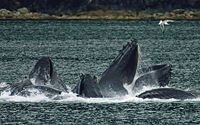


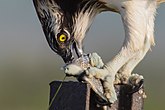
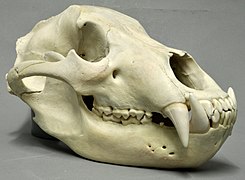

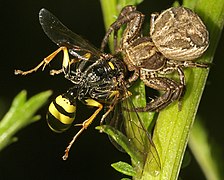

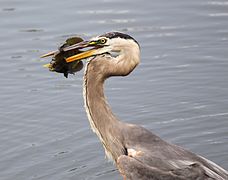
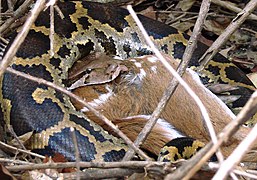






![Auroralumina attenboroughii, an Ediacaran predator (c. 560 mya). It was a stem-group cnidarian, catching prey with its nematocysts.[165]](https://upload.wikimedia.org/wikipedia/commons/thumb/6/63/Auroralumina_attenboroughii_reconstruction.jpg/157px-Auroralumina_attenboroughii_reconstruction.jpg)





